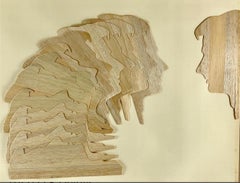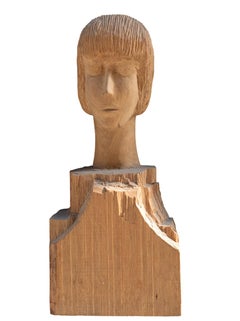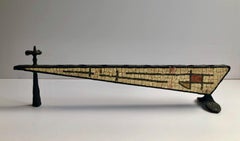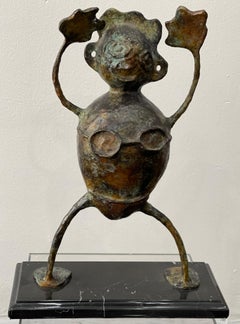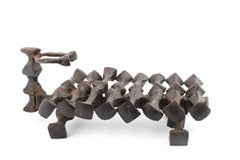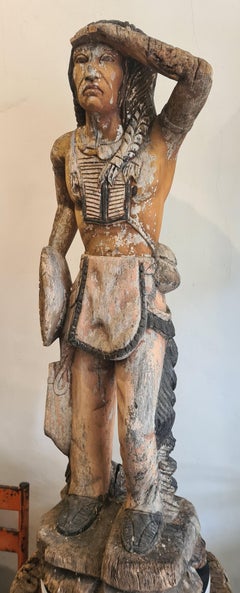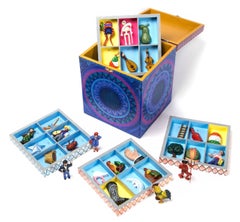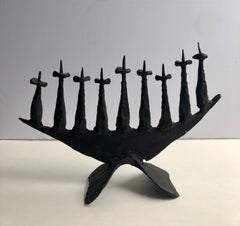Arte Povera Figurative Sculptures
to
2
1
1
1
Overall Width
to
Overall Height
to
4
1
1
5,377
797
538
356
198
94
91
76
45
35
20
17
5
3
2
2
1
1
1
1
1
3
2
2
2
2
2
1
4
1
Style: Arte Povera
1970's Large Italian Pop Art Mario Ceroli Arte Povera Sculpture Collage in Wood
By Mario Ceroli
Located in Surfside, FL
Mario Ceroli (Italian, 1938-)
Untitled
c. 1970
Wood collage on paper
Cut wood attached to paper, depicting multiple figures facing each other.
Hand signed and numbered to lower right 'Ceroli prova d'artista'. This work is an artist's proof. (not sure of edition)
Dimensions: Framed 35.5 x 47.5. sheet 27.25 x 39.5
Provenance: Basel Art Fair, 1976 CDS Gallery, New York (bears label verso)
Exhibited: Emilio Cerolli, 1976, Sala Funacion Mendoza, Caracas, Venezuela, An International Scene, 20 September - 20 December 2003, CDS Gallery, New York
Mario Ceroli, born 1938 in Castel Frentano, Province of Chieti, Italy
Mario Ceroli is an Italian sculptor. His work has been exhibited at the Museum of Modern Art in New York City and the Mississippi Museum of Art in Jackson, Mississippi. Ceroli is one of the most influential artists of the Italian post-war period. Ceroli moved to Rome at the age of ten where he later graduated from 'Accademia delle Belle Arti'. At the Art Institute he worked under the guidance of Leoncillo Leonardi, Pericle Fazzini and Ettore Colla, where he experimented with the use of ceramic. In 1958, he first exhibited these works at the Premium Spoleto. In the same year Ceroli held his first solo exhibition at Galleria San Sebastianello of Rome. During 1959 he began to experiment with new materials, particularly with raw wood, such as Russian pinewood. He used these materials to create silhouetted shapes in his furniture and objects that related simplistically to the surrounding space. In the 1960's Ceroli took part in exhibitions related to the "Arte de Povera" group. He had also been involved as screenplay director collaborating with "II Teatro Stabile" in Turin and with "La Scala" In Milan. He was part of the generation of Italian post war artists that included Aligliero Boetti, Lucio Fontana, Alberto Burri, Pino Pascali, Piero Manzoni, Enrico Castellani, Arnaldo Pomodoro, Michelangelo Pistoletto, Mimmo Rotella, Emilio Vedova. One of Ceroli's major works was his 'Mobili nella Valle' series, inspired directly by the Giorgio De Chirico 1927 painting...
Category
1970s Arte Povera Figurative Sculptures
Materials
Wood, Paper
Bust Of A Young Girl In Arte Povera Style. Italy. Mid 20th Century.
Located in Firenze, IT
Bust Of A Young Girl In Arte Povera Style, Italy,mid 20th century.
Bust of a young girl , follower of Arte Povera artistic movement, Italy, around 1970.
Sculpture in fir wood. Italy...
Category
Mid-20th Century Arte Povera Figurative Sculptures
Materials
Wood, Intaglio
Brutalist Hand Forged Iron Mosaic Sculpture Menorah Israeli David Palombo
Located in Surfside, FL
Hand Forged Iron Stone Mosaic Hanukah Menorah Candelabra
David Palombo was an Israeli sculptor and painter. He was born in Turkey to a traditional family and immigrated to the Land of Israel with his parents in 1923. They lived in the Nahalat Shiva neighborhood of Jerusalem. In 1940 he began his studies at Bezalel Academy of Arts and Design, and from 1942 was a student of sculptor Ze’ev Ben-Zvi. For a period of time, Palombo was an assistant at Ben-Zvi’s studio and also taught at Bezalel. During this period he was also a member of the “Histadrut HaNoar HaOved VeHaLomed” (The General Federation of Students and Young Workers in Israel). In the 1940s he took art lessons at night. In 1948 he went to Paris, where he visited the studio of the sculptor Constantin Brancusi whose work influenced him. Around 1958 he married the artist Shulamit Sirota. In 1960 he quit his job to devote himself to art. In 1964 he married for the second time to the artist Yona Palombo. The two of them went to live in an abandoned home on Mount Zion in Jerusalem. In 1966 he was killed when the motorcycle on which he was riding ran into a chain stretched across the street to prevent the desecration of Shabbat. His widow opened a museum in their home that was active until the year 2000.
Work by Palombo is included in the Judaic collection of the Jewish Museum (a well known Hanukkah menora). Palombo executed the impressive metal gates of the Tent of Remembrance at the Yad Vashem, the memorial to the martyrs of the holocaust, as well as the gates to the Knesset Building the United Nations Educational Scientific and Cultural Organization (Unesco award) awarded him a scholarship for study in Japan. He worked in marble, granite, bronze, iron and steel. as well as with glass mosaic tiles. Palombo’s early works, in the 1950s, were influenced by modernist sculptors such as Brancusi. These works were composed of abstract images from nature and were carved out of stone or wood. At the end of the 1950s he began making metal sculptors, using the technique of welding. His work took on a more abstract and expressive character.
Education
1940 Painting with Isidor Ascheim, New Bezalel School for Arts and Crafts, Jerusalem
1942 Sculpture with Zeev Ben Zvi, Jerusalem
1956 Mosaic, Ravenna, Italy
1958 Welding Course
Awards And Prizes
1966 UNESCO Award
Exhibitions:
Sculpture in Israel, 1948-1958 Mishkan Museum of Art, Kibbutz Ein Harod
Artists: Zvi Aldouby, Yitzhak Danziger, Arieh Merzer, Dov Feigin, Aaron Priver, David Palumbo, Menashe Kadishman, Kosso Eloul, Yehiel Shemi, Zahara Schatz.
The Spring Exhibition of Jerusalem Artists, Artists' House, Jerusalem
Artists: Palombo, David Bezalel Schatz, Mordechai Levanon, Fima, Ludwig Blum
12 Artists, The Bezalel National Museum, Jerusalem
Avraham Ofek, Aviva Uri, Avigdor Arikha, Yosl Bergner, Lea Nikel, Palombo, Ruth Zarfati...
Category
Mid-20th Century Arte Povera Figurative Sculptures
Materials
Stone, Iron
Two-sided bronze sculpture titled "Niño-Niña (Boy-Girl)"
Located in San Francisco, CA
Gabriel Mendoza
Niño-Niña (Boy-Girl), 2020
Bronze on marble base
15.50 x 11.30 x 5.20 in
Edition XII of XII
Sculpture can be shown on two sides: front side is a girl and back side i...
Category
21st Century and Contemporary Arte Povera Figurative Sculptures
Materials
Marble, Bronze
Modernist Hand Forged Iron Mosaic Sculpture Animal Ram Israeli David Palombo
Located in Surfside, FL
Heavy Hand Forged Brutalist Iron Ram or Goat Sculpture
David Palombo was an Israeli sculptor and painter. He was born in Turkey to a traditional family and immigrated to the Land of Israel with his parents in 1923. They lived in the Nahalat Shiva neighborhood of Jerusalem. In 1940 he began his studies at Bezalel Academy of Arts and Design, and from 1942 was a student of sculptor Ze’ev Ben-Zvi. For a period of time, Palombo was an assistant at Ben-Zvi’s studio and also taught at Bezalel. During this period he was also a member of the “Histadrut HaNoar HaOved VeHaLomed” (The General Federation of Students and Young Workers in Israel). In the 1940s he took art lessons at night. In 1948 he went to Paris, where he visited the studio of the sculptor Constantin Brancusi whose work influenced him. Around 1958 he married the artist Shulamit Sirota. In 1960 he quit his job to devote himself to art. In 1964 he married for the second time to the artist Yona Palombo. The two of them went to live in an abandoned home on Mount Zion in Jerusalem. In 1966 he was killed when the motorcycle on which he was riding ran into a chain stretched across the street to prevent the desecration of Shabbat. His widow opened a museum in their home that was active until the year 2000.
Work by Palombo is included in the Judaic collection of the Jewish Museum (a well known Hanukkah menora). Palombo executed the impressive metal gates of the Tent of Remembrance at the Yad Vashem, the memorial to the martyrs of the holocaust, as well as the gates to the Knesset Building the United Nations Educational Scientific and Cultural Organization (Unesco award) awarded him a scholarship for study in Japan. He worked in marble, granite, bronze, iron and steel. as well as with glass mosaic tiles. Palombo’s early works, in the 1950s, were influenced by modernist sculptors such as Brancusi. These works were composed of abstract images from nature and were carved out of stone or wood. At the end of the 1950s he began making metal sculptors, using the technique of welding. His work took on a more abstract and expressive character.
Education
1940 Painting with Isidor Ascheim, New Bezalel School for Arts and Crafts, Jerusalem
1942 Sculpture with Zeev Ben Zvi, Jerusalem
1956 Mosaic, Ravenna, Italy
1958 Welding Course
Awards And Prizes
1966 UNESCO Award
Exhibitions:
Sculpture in Israel, 1948-1958 Mishkan Museum of Art, Kibbutz Ein Harod
Artists: Zvi Aldouby, Yitzhak Danziger, Arieh Merzer, Dov Feigin, Aaron Priver, David Palumbo, Menashe Kadishman, Kosso Eloul, Yehiel Shemi, Zahara Schatz.
The Spring Exhibition of Jerusalem Artists, Artists' House, Jerusalem
Artists: Palombo, David Bezalel Schatz, Mordechai Levanon, Fima, Ludwig Blum
12 Artists, The Bezalel National Museum, Jerusalem
Avraham Ofek, Aviva Uri, Avigdor Arikha, Yosl Bergner, Lea Nikel, Palombo, Ruth Zarfati,
General Exhibition, Art in Israel 1960 Tel Aviv Museum of Art
Artists: Naftali Bezem, Nachum Gutman, Shraga Weil, Shraga, Marcel Janco, Ruth Schloss
Category
Mid-20th Century Arte Povera Figurative Sculptures
Materials
Iron
Related Items
Cigar Store Indian, Early 20th Century, Carved Wood With Polychrome Decoration
Located in Cotignac, FR
A 20th Century wood carved male figure, a 'Cigar Store Indian' with original polychrome decoration.
A now controversial subject, but none the less charming rendition, of a native North American man originally probably used as an advertising figure. Wonderful quality of carving capturing the stance of the man looking out to the distance, hair flowing to his back and plait to the side, all the details of his costume, his native dress and hairpipe breastplate (suggesting he is possibly a Comanche) and chest ornament, apron, trousers, mocassins, shield and arrows. The original Polychrome decoration has weathered beautifully as has the wood itself to present a sculpture that would adorn any collection or interior.
Because of the general illiteracy of the populace, early store owners used descriptive emblems or figures to advertise their shops' wares. American Indians and tobacco had always been associated because American Indians introduced tobacco to Europeans. As early as the 17th century, European tobacconists used figures of American Indians to advertise their shops.
Because European carvers had never seen a Native American, these early cigar-store "Indians" looked more like Africans with feathered headdresses and other fanciful, exotic features. These carvings were called "Black Boys" or "Virginians" in the trade. Eventually, the European cigar-store figure...
Category
Mid-20th Century Arte Povera Figurative Sculptures
Materials
Wood, Paint
$3,166 Sale Price
44% Off
H 37.01 in W 13.78 in D 11.82 in
8" Loteria Purpura / Wood carving Mexican Folk Art Sculpture
By Roxana y Jesus Hernandez
Located in Jesus del Monte, MX
FREE SHIPPING TO WORLDWIDE!
Artisan: Roxana y Jesus Hernandez
MASTERPIECE
Made with Copal wood, woodcarving technique gouges, machete and sandpaper, decorated with acrylic paintin...
Category
2010s Arte Povera Figurative Sculptures
Materials
Wood, Acrylic
$2,400
H 9 in W 8 in D 9 in
ABSTRACT Wood Sculpture Landscapes Black Contemporary Jonathan Freemantle
Located in Barcelona, Barcelona
At Escat Gallery we are committed to maintaining the highest standards of trust and professionalism for our collectors. Every artwork in our collection comes with a Certificate of Au...
Category
2010s Arte Povera Figurative Sculptures
Materials
Stone, Iron
$1,674
H 21.26 in W 3.55 in D 3.55 in
"The Meanderer" House Turret Tower in Wood, Acrylic and Paper Sculpture
By Seth Clark
Located in Philadelphia, PA
This piece, titled "The Meanderer" is an original free-standing sculpture by Seth Clark as part of his newest solo exhibition, "Passing Through". Clark's deteriorating structures h...
Category
21st Century and Contemporary Arte Povera Figurative Sculptures
Materials
Wood, Paper, Charcoal, Pastel, Acrylic, Graphite
$10,500
H 63 in W 20 in D 22 in
''King of the Moon'' Unique Wooden Sculpture of Astronaut with Crown
Located in Utrecht, NL
German artist Philipp Liehr first discovered his extraordinary dexterity as a dental technician. He soon perfected this artistically as a cartoonist and during his training as a scul...
Category
2010s Arte Povera Figurative Sculptures
Materials
Wood, Acrylic
$2,700
H 13.39 in W 4.73 in D 4.73 in
Westside Highway Cast Iron Roundel Art Deco - Rene Paul Chambellan
Located in Miami, FL
This sale is for one of them of the Cast Iron Roundels. However, we have 3 Cast Iron Roundels from the Old West Side Highway in Manhattan if you want to buy all three... reach out to us. . Each retains its original industrial paint. If the paint is removed, the clear shape of the iron cast will be removed. Each roundel has a different image and story. They were designed in 1928 by Rene Paul Chambellan...
Category
1920s Arte Povera Figurative Sculptures
Materials
Iron
$2,000 Sale Price
20% Off
H 2 in W 17.75 in
Bronze Abstract Space Age Book Sculpture LA California Modernist Charna Rickey
Located in Surfside, FL
Charna Rickey 1923 - 2000 Mexican-American Jewish Woman artist.
Signed Bronze House of Books, Architecture Bronze sculpture, signed Charna Rickey and on the front "House of the book." It depicts an open Torah. Original patina.
Approx. dimensions: 7 in. H x 9 in. W x 8.5 in. D. Weight: 13.1 lbs.
Modernist Judaica Sculpture
Born Charna Barsky (Charna Ysabel or Isabel Rickey Barsky) in Chihuahua, Mexico, the future artist lived in Hermosillo and immigrated to Los Angeles when she was 11. She was educated at UCLA and Cal State L.A., she married furniture retailer David Rickey and explored art while raising their three daughters. Moving through phases in terra cotta, bronze, marble and aluminum, she found success later in life. Rickey became one of the original art teachers at Everywoman's Village, a pioneering learning center for women established by three housewives in Van Nuys in 1963. She also taught sculpture at the University of Judaism from 1965 to 1981.
As Rickey became more successful, her sculptures were exhibited in such venues as Artspace Gallery in Woodland Hills and the Courtyard of Century Plaza Towers as part of a 1989 Sculpture Walk produced by the Los Angeles Arts Council. Her sculptures have also found their way into the private collections of such celebrities as Sharon Stone.
Another of Rickey's international creations originally stood at Santa Monica College. In 1985, her 12-foot-high musical sculpture shaped like the Hebrew letter "shin" was moved to the Rubin Academy of Music and Dance at Hebrew University in Jerusalem. The free standing architectural Judaic aluminum work has strings that vibrate in the wind to produce sounds. Rickey also created art pieces for the city of Brea. They commissioned some amazing art pieces by Laddie John Dill, Walter Dusenbery, Woods Davy, Rod Kagan, Pol Bury, Niki de Saint Phalle, Magdalena Abakanowicz, Larry Bell, John Okulick...
Category
20th Century Arte Povera Figurative Sculptures
Materials
Marble, Bronze
$2,200
H 7 in W 9 in D 8.5 in
Large Salvador Dali Surrealist Bronze Portrait Sculpture Mexican Master Aguilar
Located in Surfside, FL
Carlos Aguilar y Linares, Mexican Sculptor (1945-2010)
Sculpture chose him. In his hands and his soul he always had the necessary impulse to create wi...
Category
20th Century Arte Povera Figurative Sculptures
Materials
Marble, Bronze
$5,500
H 27 in W 10.5 in D 8 in
Past Lives
Located in BARCELONA, ES
According to reincarnation theory, there are lives previously lived in
different bodies.
Some people say they have memories of their past lives.
May be one of the reason that you fee...
Category
2010s Arte Povera Figurative Sculptures
Materials
Marble, Bronze, Wire
Caged Woman 2, Contemporary Verdigris Bronze Figure Suspended in Rusted Iron Orb
Located in FISTERRA, ES
Verdigris bronze figure suspended within a sculptural rusted iron orb offers a poetic meditation on confinement and transcendence. Caged Woman 2 (Ø 32 cm) by Aldonza features a slend...
Category
2010s Arte Povera Figurative Sculptures
Materials
Bronze, Iron
$956 Sale Price
20% Off
H 12.6 in Dm 12.6 in
A lady. Contemporary bronze sculpture, Abstract & figurative, Polish art
Located in Warsaw, PL
Contemporary bronze sculpture on marble base by Polish artist Stan Wysocki. Artwork comes from limited edition of 8. Sculpture depicts female figure filtered through geometric, synth...
Category
2010s Arte Povera Figurative Sculptures
Materials
Marble, Bronze
$5,979
H 23.23 in W 6.7 in D 4.73 in
Vierge en majesté. Catalogne française - Maria Lactans
Located in PARIS, FR
Rare Vierge à l'Enfant en bois polychrome de tradition romane, région du Fenouillèdes, représentant une Virgo Lactans. Avant cette découverte, seules 3 vierges allaitantes médiévales...
Category
15th Century and Earlier Arte Povera Figurative Sculptures
Materials
Wood
Previously Available Items
Modernist Brutalist Hand Forged Iron Menorah Sculpture Israeli Palombo Judaica
Located in Surfside, FL
Heavy Hand Forged Brutalist Iron Memorial Menorah Sculpture.
David Palombo was an Israeli sculptor and painter. He was born in Turkey to a traditional family and immigrated to the...
Category
Mid-20th Century Arte Povera Figurative Sculptures
Materials
Iron
Brutalist Hand Forged Iron Mosaic Sculpture Menorah Israeli David Palombo
Located in Surfside, FL
Hand Forged Iron Stone Mosaic Hanukah Menorah Candelabra
David Palombo was an Israeli sculptor and painter. He was born in Turkey to a traditional family and immigrated to the Land of Israel with his parents in 1923. They lived in the Nahalat Shiva neighborhood of Jerusalem. In 1940 he began his studies at Bezalel Academy of Arts and Design, and from 1942 was a student of sculptor Ze’ev Ben-Zvi. For a period of time, Palombo was an assistant at Ben-Zvi’s studio and also taught at Bezalel. During this period he was also a member of the “Histadrut HaNoar HaOved VeHaLomed” (The General Federation of Students and Young Workers in Israel). In the 1940s he took art lessons at night. In 1948 he went to Paris, where he visited the studio of the sculptor Constantin Brancusi whose work influenced him. Around 1958 he married the artist Shulamit Sirota. In 1960 he quit his job to devote himself to art. In 1964 he married for the second time to the artist Yona Palombo. The two of them went to live in an abandoned home on Mount Zion in Jerusalem. In 1966 he was killed when the motorcycle on which he was riding ran into a chain stretched across the street to prevent the desecration of Shabbat. His widow opened a museum in their home that was active until the year 2000.
Work by Palombo is included in the Judaic collection of the Jewish Museum (a well known Hanukkah menora). Palombo executed the impressive metal gates of the Tent of Remembrance at the Yad Vashem, the memorial to the martyrs of the holocaust, as well as the gates to the Knesset Building the United Nations Educational Scientific and Cultural Organization (Unesco award) awarded him a scholarship for study in Japan. He worked in marble, granite, bronze, iron and steel. as well as with glass mosaic tiles. Palombo’s early works, in the 1950s, were influenced by modernist sculptors such as Brancusi. These works were composed of abstract images from nature and were carved out of stone or wood. At the end of the 1950s he began making metal sculptors, using the technique of welding. His work took on a more abstract and expressive character.
Education
1940 Painting with Isidor Ascheim, New Bezalel School for Arts and Crafts, Jerusalem
1942 Sculpture with Zeev Ben Zvi, Jerusalem
1956 Mosaic, Ravenna, Italy
1958 Welding Course
Awards And Prizes
1966 UNESCO Award
Exhibitions:
Sculpture in Israel, 1948-1958 Mishkan Museum of Art, Kibbutz Ein Harod
Artists: Zvi Aldouby, Yitzhak Danziger, Arieh Merzer, Dov Feigin, Aaron Priver, David Palumbo...
Category
Mid-20th Century Arte Povera Figurative Sculptures
Materials
Stone, Iron
H 4.5 in W 15.5 in D 3 in
Large Modernist Hand Forged Iron Menorah Sculpture Knesset Israeli David Palombo
Located in Surfside, FL
Heavy Hand Forged Brutalist Iron Memorial Menorah Sculpture
This relates to his most important commission the gates at the Knesset in Jerusalem Israel. I have included a photo of the...
Category
Mid-20th Century Arte Povera Figurative Sculptures
Materials
Iron
H 8.25 in W 18.5 in D 9 in
Modernist Hand Forged Iron Mosaic Sculpture Animal Ram Israeli David Palombo
Located in Surfside, FL
Heavy Hand Forged Brutalist Iron Ram or Goat Sculpture
David Palombo was an Israeli sculptor and painter. He was born in Turkey to a traditional family and immigrated to the Land of Israel with his parents in 1923. They lived in the Nahalat Shiva neighborhood of Jerusalem. In 1940 he began his studies at Bezalel Academy of Arts and Design, and from 1942 was a student of sculptor Ze’ev Ben-Zvi. For a period of time, Palombo was an assistant at Ben-Zvi’s studio and also taught at Bezalel. During this period he was also a member of the “Histadrut HaNoar HaOved VeHaLomed” (The General Federation of Students and Young Workers in Israel). In the 1940s he took art lessons at night. In 1948 he went to Paris, where he visited the studio of the sculptor Constantin Brancusi whose work influenced him. Around 1958 he married the artist Shulamit Sirota. In 1960 he quit his job to devote himself to art. In 1964 he married for the second time to the artist Yona Palombo. The two of them went to live in an abandoned home on Mount Zion in Jerusalem. In 1966 he was killed when the motorcycle on which he was riding ran into a chain stretched across the street to prevent the desecration of Shabbat. His widow opened a museum in their home that was active until the year 2000.
Work by Palombo is included in the Judaic collection of the Jewish Museum (a well known Hanukkah menora). Palombo executed the impressive metal gates of the Tent of Remembrance at the Yad Vashem, the memorial to the martyrs of the holocaust, as well as the gates to the Knesset Building the United Nations Educational Scientific and Cultural Organization (Unesco award) awarded him a scholarship for study in Japan. He worked in marble, granite, bronze, iron and steel. as well as with glass mosaic tiles. Palombo’s early works, in the 1950s, were influenced by modernist sculptors such as Brancusi. These works were composed of abstract images from nature and were carved out of stone or wood. At the end of the 1950s he began making metal sculptors, using the technique of welding. His work took on a more abstract and expressive character.
Education
1940 Painting with Isidor Ascheim, New Bezalel School for Arts and Crafts, Jerusalem
1942 Sculpture with Zeev Ben Zvi, Jerusalem
1956 Mosaic, Ravenna, Italy
1958 Welding Course
Awards And Prizes
1966 UNESCO Award
Exhibitions:
Sculpture in Israel, 1948-1958 Mishkan Museum of Art, Kibbutz Ein Harod
Artists: Zvi Aldouby, Yitzhak Danziger, Arieh Merzer, Dov Feigin, Aaron Priver, David Palumbo...
Category
Mid-20th Century Arte Povera Figurative Sculptures
Materials
Iron
H 8.25 in W 18.5 in D 9 in
Arte Povera figurative sculptures for sale on 1stDibs.
Find a wide variety of authentic Arte Povera figurative sculptures available for sale on 1stDibs. Works in this style were very popular during the 20th Century, but contemporary artists have continued to produce works inspired by this movement. Many Pop art paintings were created by popular artists on 1stDibs, including David Palombo, and Guenther Uecker. Frequently made by artists working with Metal, and Iron and other materials, all of these pieces for sale are unique and have attracted attention over the years. Not every interior allows for large Arte Povera figurative sculptures, so small editions measuring 6.5 inches across are also available. Prices for figurative sculptures made by famous or emerging artists can differ depending on medium, time period and other attributes. On 1stDibs, the price for these items starts at $1,664 and tops out at $5,600, while the average work sells for $2,200.
